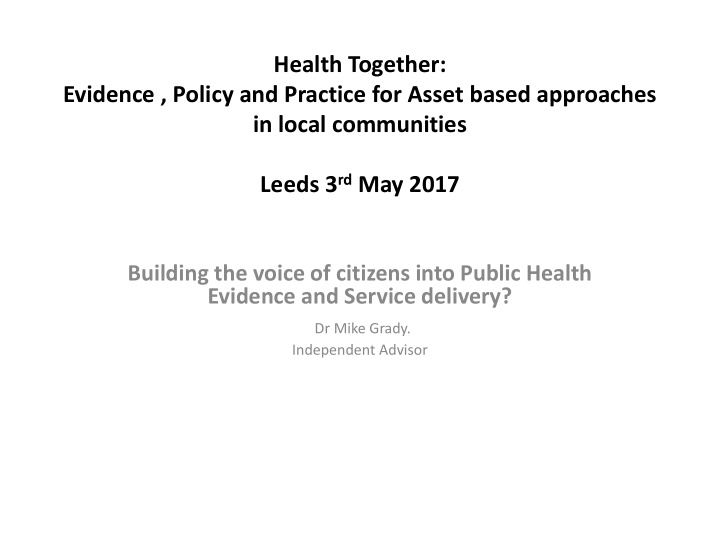



Health Together: Evidence , Policy and Practice for Asset based approaches in local communities Leeds 3 rd May 2017 Building the voice of citizens into Public Health Evidence and Service delivery? Dr Mike Grady. Independent Advisor
Review of the Social Determinants of Health and the Health Divide in the WHO European Region The CSDH – closing the The Marmot Review – Fair gap in a generation Society Healthy Lives
Property and Inequality Guardian 22 nd April 2017. Ian Jack.
Level of development at end of reception School Readiness: the percentage of children achieving a good level of development at the end of reception 2012/13 80 % 70 60 England all 50 40 30 Linear (England all) 20 10 0 0 1 2 3 4 5 Most deprived Least deprived IMD Quntile Cited Building Coomunity Resilience for Health M Grady IHE,UCL presentation 2015.
NORTHERN ENGLAND and EDUCATION DIVIDE
HIDING IN PLAIN SIGHT The Economist 22 nd August 2015
What is What enhances my detrimental to wellbeing and my wellbeing health and health Lack of Recycling interesting facilities activities in winter Green spaces that I can use Poor local job Affordable prospects healthy food Poor street Affordable lighting and transport uneven pathways Spending Soaring fuel time with my bills and neighbours poor insulation
People and Places • Critical linkage of health, wellbeing and resilience. • Evidence of linkage of low level stress, depression and exclusion are barriers to participation. “ You can see the deprivation, all you have to do is look outside. Its in your face every day, litter everywhere, rats and rubbish. It’s a dump……it feels like people around you have no meaning to life. I keep my curtains closed at times….It doesn’t give you a purpose to do anything” (Focus group participant) • Many communities are characterised by lack of mutual trust, isolation and under developed social cohesion.
Health, Wellbeing and resilience • Evidence participation and improving life skills ameliorates impact of health inequalities through developing social support networks . (Bynner and Parsons 2006) • Learning and skill development impact positively and fosters community action. “ I know what makes me healthy and that is being happy and having friends” (Susanne) • Social networks create the conditions in which people thrive “ I would say that people in the group have more confidence. At one point they would have been sat at home doing nothing ,now they are out and are involved. Once you get there it ‘s amazing to see how far you can go.” (Joyce)
Broad action to improve health literacy and reduce health inequalities A. Social determinants of health • efforts to improve health literacy which support action on the key social conditions are likely to have more impact • Community-based peer-support programmes where peer-support workers have things in common with participants, allow participants to engage in discussions on issues which matter to them, and encourage participants to be involved in social networks where problems, concerns and tips can be shared. Harris J, Springett J, Croot L, Booth A, Campbell F, Thompson J, et al. Can community-based peer support promote health literacy and reduce inequalities? A realist review. Public Health Res. 2015;3(3):214 cited in .
Policy Drivers : Joint Sovereignty and Place Integrated Services with Better outcomes delivered cost effectively Early Intervention and prevention increases local independence Strong Community Leadership fostering co-design and co-production of strategy, policies and services. NHS 5 Year Forward View : A New Relationship with Patients and Communities
THE FULLY ENGAGED COMMUNITY : ( Wanless 2004)
Recommend
More recommend